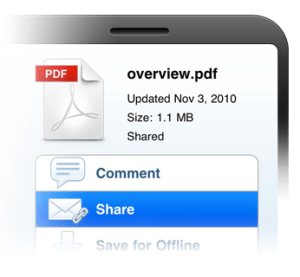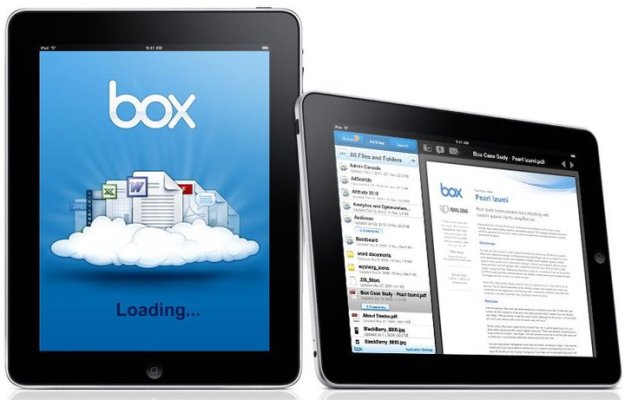Cloud storage platform Box (which you no longer have to refer to as Box.net as it now owns Box.com!), has seen incredible growth over the past year, both on the consumer and on enterprise side. Much of the growth has been driven by mobile, with the company seeing a 140% increase in mobile customer implementations each month in 2011, leading the total number of new mobile users to jump up by 171% monthly.
By year end 2011, Box’s total mobile user count reached 1.9 million, up 9 times over 2010. But nowhere has mobile’s impact been more felt than in the enterprise, where iOS and Android especially have driven business adoption of not just mobile apps, but the cloud in general.
In terms of mobile platform adoption, there were more than 1.2 million iOS app downloads in 2011, 462,000 on Android, 200,000 webOS downloads and 51,000 on PlayBook. (Yes, PlayBook!) These numbers include both consumer and enterprise growth combined, however.
But when Box tracks its enterprise sales, it tracks the reason for buying, and this past year, the company found there was a 30x increase in the number of enterprise deployments that were mobile-driven. So while mobile user growth may be up 9x, the sheer need for mobile connectivity is what’s driving its business. The mobile needs of the enterprise is affecting the company’s bottom line with Box seeing 3x revenue growth over the past year, as large organizations, like Procter & Gamble, McAfeee and AAA for example, signed up for the service. The enterprise customer base, meanwhile, grew by 2x and now includes 82% of the Fortune 500.
In the enterprise, iOS (iPhone, iPad) saw the most adoption, with 5 times year-over-year growth from 2010. Interestingly, Android is growing at a faster rate: 7 times year-over-year growth, even though it isn’t the largest mobile platform Box supports (iOS is, and more so the iPad).
Specific industry verticals are adopting Box at a faster rate than others, too, with the biggest jump coming from the Food and Beverage industry (up 7x), where Box counts Red Bull, Dole, PBR and others as customers. Because of the workflow-based nature of many of the industry’s tasks – like tracking product from the field to processing – this group was also big on the building custom applications on top of Box’s platform. Box now has over 130 apps integrated with its service and 5,000 developers.
Meanwhile, more traditional use cases involving knowledge worker and document sharing led to greater adoption in Financial Services (up 3.5x) and Health Care (up 3x) in 2011.
What’s interesting about these mobile adoption trends is the impact they’re having on cloud adoption. Says Box’s VP of Mobile, Matthew Self, “one of the big drivers we see for mobile adoption – and one of the big reasons why mobile deployment growth was actually higher than the user growth – has to do with the fact that enterprises are adopting cloud services because of mobile.”
“Mobile adoption is actually driving cloud adoption,” he says, “which isn’t totally obvious. But when you get to mobile, it isn’t about Microsoft anymore. Less than half of the computing endpoints in the world are Microsoft now…They’ve forced CIO’s to defect from Microsoft’s own entrenched postion, which is sort of bizarre. But it’s not like a CIO can say, ‘oh, I’ll just wait a year or two on mobile.'”
Ouch! (But totally right).

This exit from the Microsoft era is all the more evident in smaller to medium-sized businesses, which by their very nature, have had to be scrappy, turning to low-cost, easy-to-manage cloud services as an alternative to a traditional I.T. infrastructure. But the tide is turning. More enterprises are arriving at Box, which often represents their first or second toe dipped into the water of cloud computing. Maybe they use Salesforce, or some small cloud service on the side, but many are still Microsoft-based organizations running Exchange and Office.
Box then slides into place as a supplement to traditional systems like SharePoint then becomes the system of choice, leaving businesses to wonder why they still need the old system at all. In 2012, Box plans to help those folks cut the cord even more by implementing a new feature that will allow mobile users the ability to not only access, but also edit and comment on documents via the Box mobile app without needing another app supporting that file type installed on their mobile device. (For example, edit a spreadsheet on iOS with Apple’s Numbers app).
Self says Box’s move here is reflective of the move to more “cloud-augmented” apps, which he points out is already a big trend in consumer’s mobile computing behavior.
“These are apps where the bulk of the interesting work is happening in the cloud, not the mobile device at all,” he explains. For example, Apple’s Siri, where the voice recognition and processing work is happening in the cloud, and the iPhone is just recording what you say then playing back the results. Or Amazon’s Silk browser, which runs in the cloud, where only the UI (the presentation) is taking place on the mobile device. This too, mirrors Box’s plan for mobile: use HTML5 and web services for the business logic, while the UI/presentation layer renders through native code.
Combined with an increasing acceptance of using secure mobile apps (versus securing the whole mobile platform, e.g. RIM/BlackBerry Server solutions), it’s going to be easier than ever for enterprise customers to cut legacy connections altogether.
